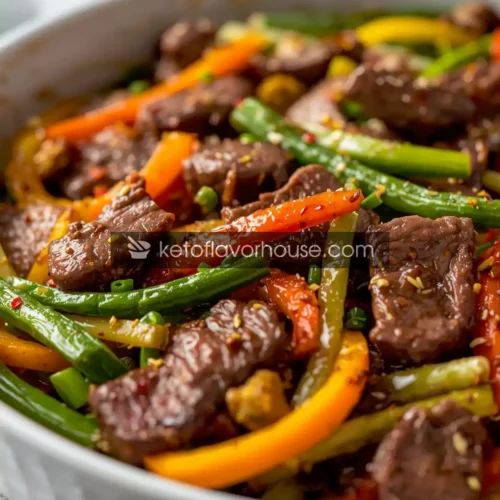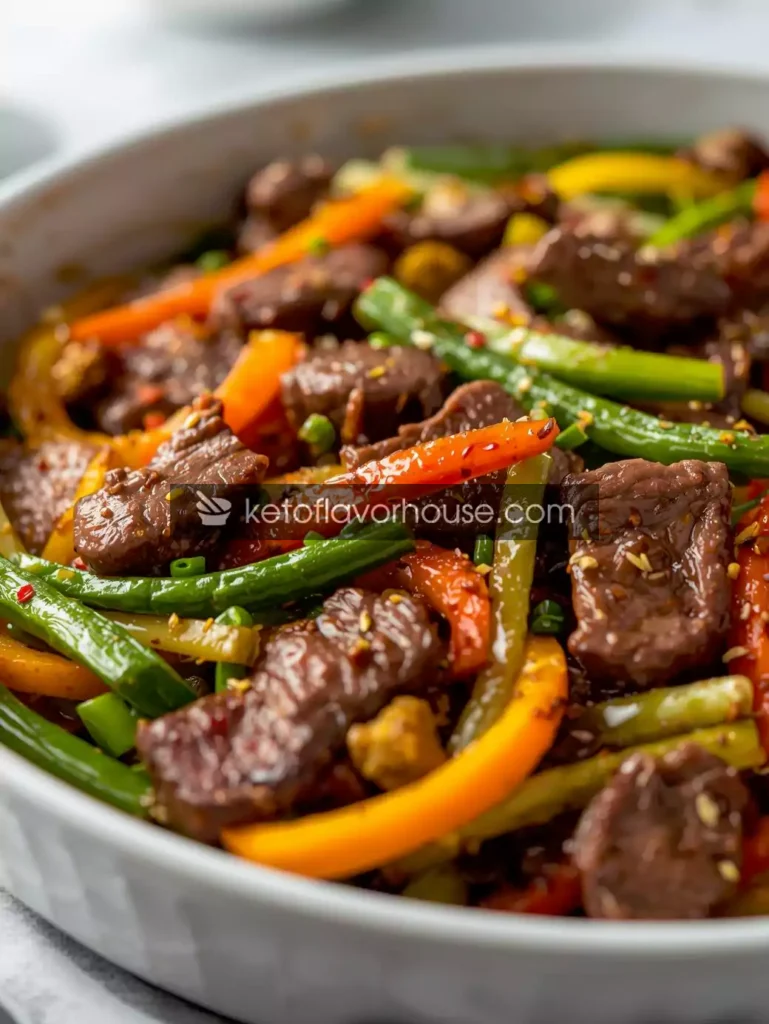This post may contains Amazon affiliate and other affiliate links. If you make a purchase through these links, I may earn a small commission at no extra cost to you. Your support helps me continue to provide quality content. I only recommend products I personally trust and believe will add value to your experience. For more details, please visit my Privacy Policy.
🥢 A Story from My Kitchen
There’s something magical about a sizzling stir fry — the rhythmic sound of veggies hitting a hot pan, the aroma of fresh garlic and ginger blooming in sesame oil, and that glossy sauce coating every bite. I still remember the first time I made this Bariatric Ginger Beef Stir Fry after my weight loss surgery — I was craving something bold and comforting yet completely within my bariatric meal plan.
Most takeout-style stir fries are drenched in sugary sauces and cornstarch, making them off-limits for post-op meals. But I wasn’t ready to give up those flavors — that spicy ginger kick, the tender beef strips, and the crisp vegetables. So I created this version: high in protein, low in carbs, and absolutely bursting with flavor.
Whether you’re in the early stages of your bariatric journey or years post-op and simply eating clean, this dish hits every note — balanced, filling, and deeply satisfying.
🌟 What Makes This Recipe Stand Out
This isn’t just a stir fry — it’s a confidence booster for anyone learning to love food again after bariatric surgery. It’s easy to digest, packed with lean protein, and portion-perfect without feeling restrictive.
Plus, it takes less than 25 minutes from pan to plate — making it ideal for busy weeknights.
Here’s what sets it apart:
- Low-carb and sugar-free: No cornstarch or sugary sauces.
- Bariatric portioned: High in protein, low in calories, and easy to chew.
- Customizable: Works with beef, chicken, tofu, or shrimp.
- One-pan magic: Fewer dishes, more flavor!
💫 Why You’ll Love It
- 🥩 Packed with lean protein to keep you full longer
- 🫚 Loaded with fresh ginger and garlic for metabolism support
- 🥦 Filled with fiber-rich veggies that aid digestion
- 🍜 Quick, one-pan prep — perfect for busy nights
- 🧄 Sugar-free and low in carbs for post-op nutrition goals
🍳 Equipment You’ll Need
You don’t need a fancy wok — just these kitchen basics:
- Non-stick skillet or wok: Helps you sear beef evenly without extra oil.
- Sharp knife: For thinly slicing beef against the grain.
- Mixing bowl: To marinate your beef in the ginger-soy blend.
- Spatula or tongs: To toss everything together without breaking the meat.
- Measuring spoons: To keep your sodium and sauce ratios precise.
💡 Tip: Preheat your pan before adding oil — this locks in that perfect sear and keeps your beef juicy.
🥩 Ingredients You’ll Need
For the Beef & Marinade:
- 8 oz (225g) lean beef strips (sirloin or flank steak, trimmed of fat)
- 1 tbsp low-sodium soy sauce (or coconut aminos for gluten-free)
- 1 tsp sesame oil
- 1 tsp minced fresh ginger
- 1 tsp minced garlic
- ½ tsp rice vinegar or apple cider vinegar
- Pinch of black pepper
For the Stir Fry:
- 1 tsp olive oil or avocado oil
- ½ cup broccoli florets (lightly steamed)
- ½ cup sliced bell peppers (any color)
- ¼ cup thinly sliced carrots (optional, for color and crunch)
- ¼ cup chopped onions
- 2 tbsp water or low-sodium broth (to steam veggies slightly)
For the Sauce (Sugar-Free):
- 1 tbsp soy sauce or tamari
- ½ tsp grated fresh ginger
- ½ tsp garlic, minced
- 1 tbsp sugar-free teriyaki or hoisin sauce (optional, bariatric-safe)
- ¼ tsp xanthan gum (optional, for thickening)
👩🍳 Step-by-Step Cooking Instructions
Step 1: Marinate the Beef
In a bowl, combine the beef strips with soy sauce, sesame oil, ginger, garlic, vinegar, and pepper. Toss well and let it marinate for at least 15 minutes (or overnight if you want deeper flavor).
This not only tenderizes the beef but also infuses it with that signature Asian aroma.
Step 2: Sear the Beef
Heat your non-stick skillet or wok over medium-high heat. Add 1 tsp olive oil and spread it evenly. Once hot, add your marinated beef in a single layer.
Let it sear undisturbed for 1–2 minutes, then stir-fry for another 2–3 minutes until browned and cooked through. Remove and set aside.
Step 3: Cook the Veggies
In the same pan, add onions and a splash of broth. Sauté for 1 minute, then add bell peppers, broccoli, and carrots. Stir-fry for another 2–3 minutes until crisp-tender.
If needed, cover with a lid for 30 seconds to help the veggies steam slightly without getting mushy.
Step 4: Combine & Add Sauce
Return the cooked beef to the pan. Add all sauce ingredients — soy sauce, garlic, ginger, and sugar-free teriyaki (if using).
Toss everything well, letting the sauce coat each piece. If you want a thicker texture, sprinkle a pinch of xanthan gum and stir for 20 seconds — it’ll give that glossy, restaurant-style finish.
Step 5: Serve & Enjoy
Remove from heat, let cool slightly, and serve warm.
For portion control, bariatric servings should be around ½ to ¾ cup total, depending on your stage and tolerance.
🥗 How to Serve It
- As-is: Enjoy it as a protein-and-veggie meal bowl.
- Over cauliflower rice: For a more filling low-carb dinner.
- With shirataki noodles: Adds volume with almost zero carbs.
- Lettuce wraps: Spoon it into romaine leaves for a crunchy twist.
🍱 Storage & Meal Prep Tips
This recipe is a meal-prepper’s dream!
- Fridge: Store leftovers in an airtight container for up to 4 days.
- Freezer: Freeze in single portions for up to 2 months.
- Reheat: Microwave for 1 minute or reheat in a skillet with a splash of water.
Pro tip: Always reheat gently to avoid overcooking the beef.
🧠 Health & Nutrition Insights
This Bariatric Ginger Beef Stir Fry fits beautifully into your post-op eating plan.
- High protein: Supports muscle recovery and keeps you full longer.
- Low in carbs: Perfect for maintaining ketosis or weight loss.
- Ginger & garlic: Help with digestion, inflammation, and immunity.
- No added sugars: Keeps your blood sugar stable.
It’s the kind of meal that makes you feel like you’re not dieting — just eating smart.
Bariatric Nutrition & Strategy
When I developed this Bariatric Ginger Beef Stir Fry, I kept one rule front and center: make every bite count. For anyone following a bariatric plan, meals aren’t just about flavor — they’re tiny windows to deliver the protein, vitamins, and minerals your body needs while keeping volume, carbs, and unnecessary sugar low. That’s exactly where this stir fry shines. The lean beef takes center stage as a concentrated source of complete protein, iron, and B-vitamins (especially B12) — all essential for healing, energy and preserving lean muscle. Paired with colorful, fiber-rich vegetables and a sugar-free, low-sodium sauce, this dish gives you a nutrient-dense plate without excess calories or carbs.
Why lean beef is bariatric-friendly
Lean beef is one of those ingredients that feels indulgent but is incredibly practical for post-op nutrition. It supplies high-quality protein in a relatively small portion — which means you meet your protein goals without overeating. Beef also provides heme iron, which is more readily absorbed than non-heme plant iron; that’s helpful because iron deficiency can be a concern after bariatric surgery. And let’s not forget B12 — often depleted after surgery — which helps ward off fatigue and supports nerve health. In short: a modest serving of well-trimmed beef is efficient nutrition for a small stomach.
How this recipe fits into a bariatric plan
This stir fry was built to slot easily into a bariatric daily plan:
- Portion control: Serve bariatric portions (roughly ½ to ¾ cup depending on your stage and tolerance) so you prioritize protein first and avoid overfilling.
- Protein-first plate: Start your meal with the beef portion, then add vegetables. This order helps with satiety and digestion.
- Low-carb base options: If you want more volume, pair it with cauliflower rice or shirataki noodles instead of rice — both keep carbs low while adding bulk.
- Texture considerations: The beef is sliced thin and cooked quickly so it’s tender and easy to chew — important for those in the soft-to-regular food phases. If you’re earlier in recovery, chop very small or gently simmer to soften further.
Practical daily strategies
- Aim for protein at every meal. Think of this stir fry as a protein anchor. Many bariatric plans emphasize protein across meals to preserve muscle and support healing. Use a food scale or portion guidance from your dietitian to measure your serving if you’re tracking.
- Hydration timing. Sip fluids between meals rather than during them to avoid overfilling and to improve protein intake at mealtime.
- Micronutrient pairing. Combine the beef with vitamin C-rich vegetables (bell peppers, broccoli) — that boosts iron absorption naturally. A squeeze of lemon over the finished dish is a tiny trick with a big payoff.
- Watch sodium and sauces. Flavors matter, but store-bought sauces are often high in sodium and hidden sugars. This recipe’s sugar-free, low-sodium sauce keeps taste high and sodium low; adjust to your own sodium tolerance and your surgeon’s guidance.
Easy swaps to keep it tailored
- For lower fat: Use extra-lean cuts (top round, eye of round) or thinly sliced sirloin.
- For extra protein: Serve the stir fry alongside a small cup of cottage cheese or a Greek yogurt-based dip as a snack later in the day.
- For plant-based days: Swap beef for extra-firm tofu or tempeh and keep the same flavor profile; you’ll get protein without the heme iron — so pair with vitamin C–rich sides for better absorption.
Meal timing & pairing suggestions
- Post-op breakfast/lunch idea: A smaller portion of stir fry over cauliflower rice for lunch keeps energy stable through the afternoon.
- Dinner: Combine your ½–¾ cup serving with a side of steamed greens and a half-cup of mashed cauliflower for comfort and volume without excess carbs.
- Snack strategy: If your appetite is limited, split the meal: enjoy half as dinner and reserve the rest for a protein-rich snack later. This preserves daily protein while easing digestion.
📊 Nutrition Breakdown (per serving)
| Nutrient | Amount |
|---|---|
| Calories | 220 kcal |
| Protein | 28g |
| Fat | 9g |
| Carbohydrates | 7g |
| Net Carbs | 5g |
| Fiber | 2g |
(Estimated for one bariatric-sized serving, using lean beef and no added sugar sauces.)
❓ FAQ
1. Can I use chicken instead of beef?
Yes! Lean chicken breast or ground chicken works beautifully — just reduce cooking time slightly.
2. What if I’m in the soft food stage post-surgery?
Use extra-tender beef and chop the veggies finely or cook them longer for a softer texture.
3. Can I make it vegetarian?
Absolutely — swap beef for tofu or tempeh and use coconut aminos instead of soy sauce.
4. Is this spicy?
Not by default. You can add a dash of chili flakes or sriracha if you like heat.
5. Can I meal prep this for the week?
Yes — it reheats perfectly and stays flavorful for days!
🕒 Recipe Details
| Category | Info |
|---|---|
| Prep Time | 10 minutes |
| Cook Time | 15 minutes |
| Total Time | 25 minutes |
| Course | Main Course |
| Cuisine | Asian / Bariatric |
| Servings | 4 |
| Calories per Serving | 220 kcal |

Bariatric Ginger Beef Stir Fry Recipe
Ingredients
- 1 lb 450g lean beef sirloin, thinly sliced
- 1 tbsp sesame oil or olive oil
- 2 cups broccoli florets
- 1 medium bell pepper sliced
- 1 small zucchini sliced into half-moons
- 2 cloves garlic minced
- 1 tbsp fresh ginger minced
- 2 tbsp low-sodium soy sauce or coconut aminos
- 1 tbsp rice vinegar or apple cider vinegar
- 1 tsp sesame seeds optional for garnish
- 1 green onion sliced (for topping)
- Salt and pepper to taste
Instructions
- Prep the Beef:
- Slice the lean beef into thin strips. Pat dry with paper towels — this helps you get that perfect sear later.
- Make the Sauce:
- In a small bowl, mix together soy sauce, rice vinegar, minced ginger, and garlic. Set aside.
- Sear the Beef:
- Heat sesame oil in a non-stick skillet or wok over medium-high heat. Add beef strips and cook for 2–3 minutes per side until lightly browned. Remove and set aside.
- Cook the Vegetables:
- In the same pan, add broccoli, zucchini, and bell pepper. Stir-fry for 3–4 minutes until just tender but still crisp.
- Combine Everything:
- Return the beef to the pan. Pour in the sauce and stir well to coat. Let it cook for another 2 minutes so flavors meld together.
- Garnish & Serve:
- Sprinkle with sesame seeds and sliced green onions. Serve hot as is, or with a few cauliflower rice spoonfuls for extra fiber.









